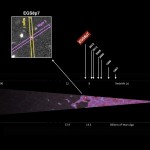W. M. Keck Observatory press release…
A team of astrophysicists using the W. M. Keck Observatory in Hawaii has successfully measured the farthest galaxy ever recorded and more interestingly, captured its hydrogen emission as seen when the Universe was less than 600 million years old. Additionally, the method in which the galaxy called EGSY8p7 was detected gives important insight into how the very first stars in the Universe lit-up after the Big Bang. The paper will be published shortly in the Astrophysical Journal Letters.

cosmic reionization’, the process by which dark clouds of hydrogen were split into their constituent protons and electrons by the first generation of galaxies.
“We frequently see the Lyman-alpha emission line of hydrogen in nearby objects as it is one of most reliable tracers of star-formation,” said California Institute of Technology (Caltech) astronomer, Adi Zitrin, lead author of the discovery paper. “However, as we penetrate deeper into the Universe, and hence back to earlier times, the space between galaxies contains an increasing number of dark clouds of hydrogen which absorb this signal.”
Recent work has found the fraction of galaxies showing this prominent line declines markedly after when the Universe was about a billion years old, which is equivalent to a redshift of about 6. Redshift is a measure of how much the Universe has expanded since the light left a distant source and can only be determined for faint objects with a spectrograph on a powerful large telescope such as the Keck Observatory’s twin 10-meter telescopes, the largest on Earth.
Continue reading "New Record: Keck Observatory Measures Most Distant Galaxy"


